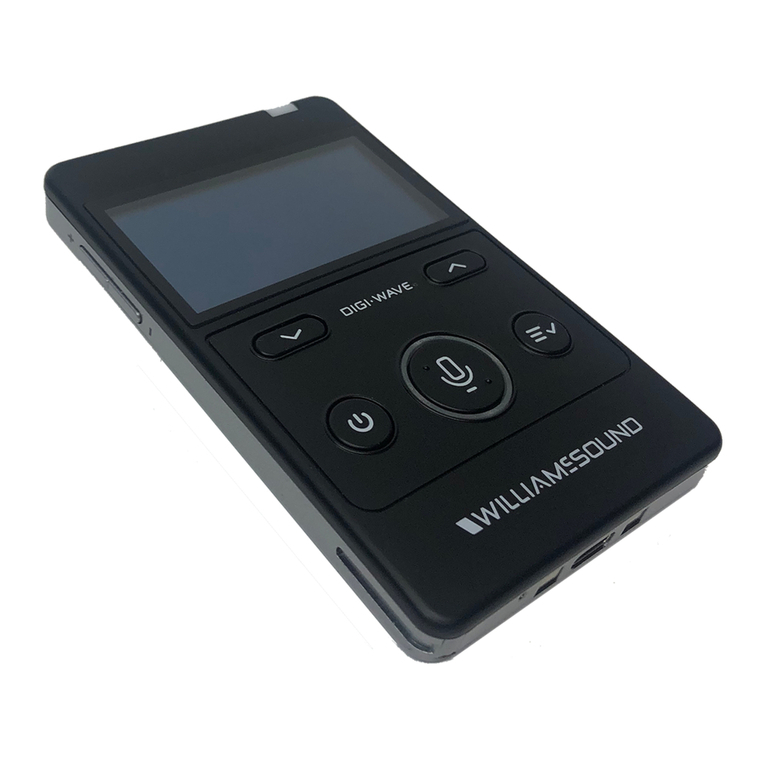
DigiWave 300 Series Digital Transceiver and Receiver
4
System Overview
The Digi-wave™ system is a patented, digital spread-spectrum (DSS), simultaneous two-way wireless listening system
operating in the 2.4 GHz band. Due to it’s frequency-hopping algorithm, it avoids interference and is a very secure method of
communication. For a more detailed explanation of how Digi-wave technology works, please visit our website and download
the “Digi-wave™ Technology White Paper” (under “Support – Downloads - Tech Bulletins”).
A Digi-Wave communication system consists of at least one transceiver (DLT 300 ) and various combinations of transceivers and
receivers (DLR 360 ) depending on the venue.
The DLT 300 is a two-way transceiver, meaning that it can transmit and receive audio simultaneously. It can operate in one of 3
dierent modes:
1. In Two-way Mode, a speaker (with a DLT 300) can hear another speaker’s voice (from a second DLT 300) and,
at the same time, can also transmit their own voice. In this way, two-way communication is established (similar to a
phone conversation). Two-way mode can only be established between DLT 300 units. In addition, DLR 360 receivers
in the same group can also hear the broadcast.
2. In One-way Mode, one DLT 300 acts as a transmitter (speaker) and another DLT 300 acts as a receiver (listener).
In addition, DLR 360 receivers in the same group can also hear the broadcast. There are 4 one-way modes.
3. In Repeater Mode, the DLT 300 receives audio from another DLT 300 and re-broadcasts the signal to increase the
transmitted range of the person speaking. In this way, larger groups can be covered by using one or more DLT 300’s
acting as repeaters. Listeners can have either DLT 300’s or DLR 360’s to listen to the broadcast.
The Repeater function only operates in 1-way mode. It is not available in a 2-way scenario.
4. In Intercom Mode, up to six people can talk simultaneously. All of the DLT 300’s are in 2-way mode in the same
group. More DLT’s can be in the group, but only six can have live mics at the same time (the seventh DLT who wishes
to speak pushes their TALK button and knocks the sixth talker o). DLR’s can listen-in on the conversation if desired.
The DLR 360 is a receiver only. Users of receivers can only hear what is being broadcast by DLT(s).
Combinations of one or more DLT 300’s and DLR 360’s in One-way mode, Two-way mode, or Repeater mode can be used to
facilitate dierent events, depending on what needs to be spoken and what needs to be heard. Examples of scenarios will be
covered here.
Typical Scenarios include:
Guided Tours - with one or more tour guides (2-way), with audience participation (2-way), or without audience participation (1-way)
Language Interpretation - one or more interpreted languages transmitted to audience (1-way)
Intercom - with up to six people able to speak simultaneously (2-way)
There are many more scenarios than are covered in this manual, however these would be variations on the ones discussed
here. Rules of Operation for 1-way or 2-way mode must be followed for successful operation.
For simplicity, throughout the rest of this manual, the DLT 300 may be referred to as a “DLT” and the DLR 360 as a
“DLR”. Similarly, Master 1, Master 2 and Guest may be referred to as “M1”, “M2”, and “GST”.
The Digi-Wave 300 Series is not backward compatible with previous generation transceivers or
receivers (DLT 100, DLT 100 2.0, DLR 50, DLR 60, and DLR 60 2.0).





























